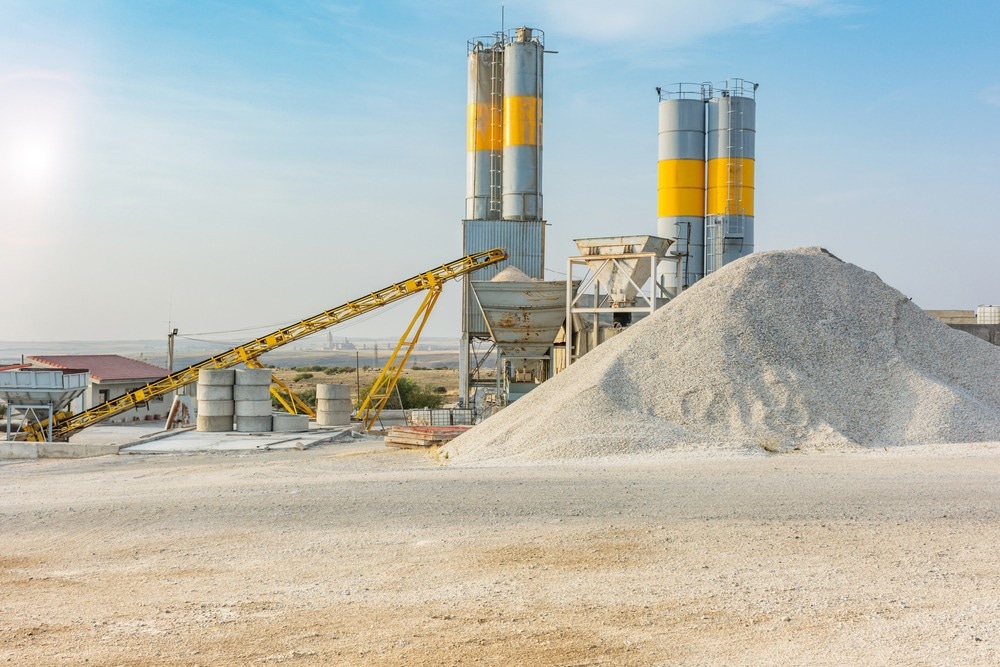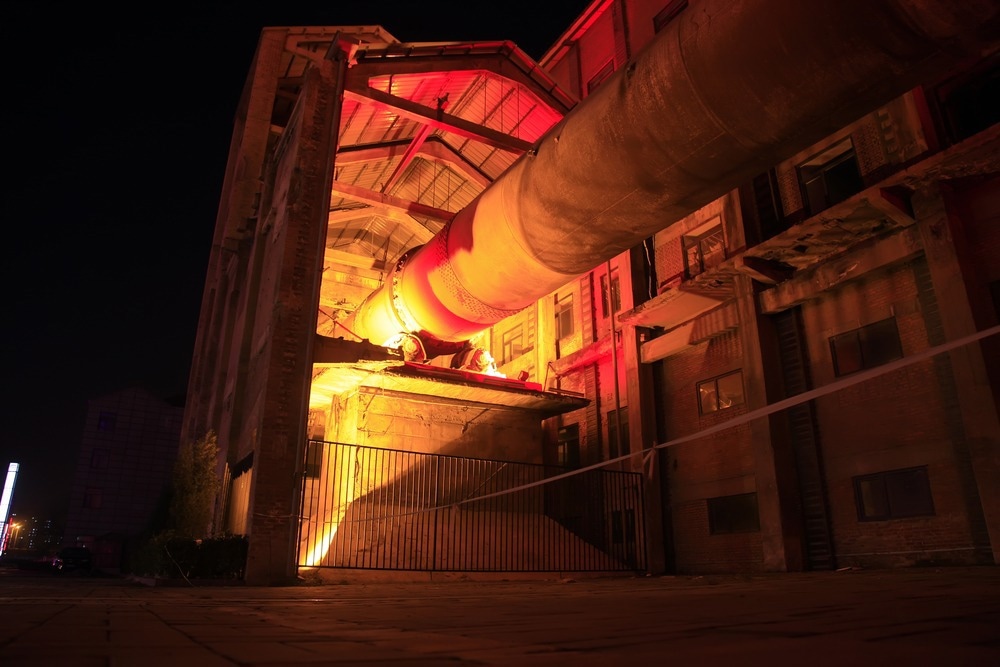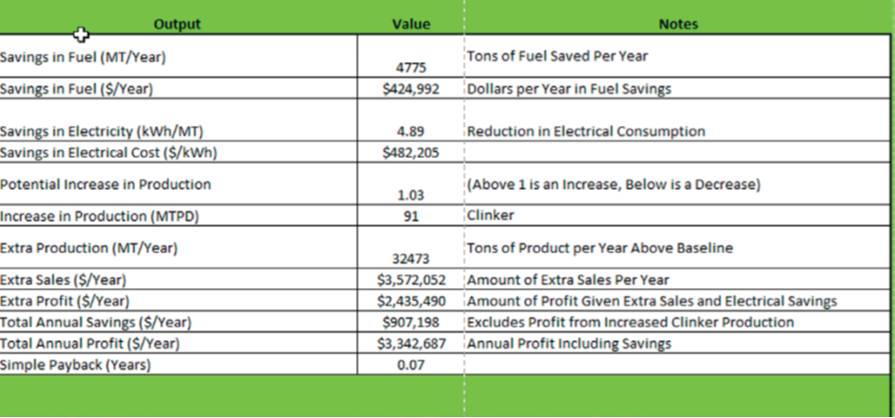In this interview, Murielle Goubard, the Global Sector Manager for Building Materials at Malvern Panalytical, talks to AZoMaterials about sustainable challenges in the cement industry.
How does your work relate to cement development and production?
My main job is to help our customers solve their current concerns, as well as address the new and future challenges facing their industry. Among construction materials, cement is one of the most important, both in its own right and as a constituent of concrete.
My role is to identify effective analytical solutions for critical issues, including decarbonizing cement production, recycling raw materials, controlling energy consumption, and digitizing processes—key success factors in all these areas—while simultaneously maintaining or even improving the final properties of cement and concrete.

Image Credit: Banana Republic images/Shutterstock.com
This implies having the opportunity to exchange ideas with specialists in the field and integrating local specificities, including regulatory requirements and the availability of materials for the plants. Additionally, a particularly exciting aspect of my role involves combining my analytical knowledge with cement manufacturing expertise to envision and develop novel solutions that prioritize efficiency, robustness, predictive approaches, and cost control.
What changes has the cement industry undergone these last years?
For over 40 years, cement manufacturers have been working to reduce their environmental impact, particularly their CO2 emissions.
To achieve this, several actions have been taken:
- Improving the energy efficiency of kilns and processes.
- Using alternative fuels (industrial residues, biomass, etc.) to partially replace the fossil fuels used to power cement kilns.
- Using alternative raw materials.
- Manufacturing new multi-constituent cements (combining clinker with slag, fly ash, calcined clay, limestone, etc.) and reducing the clinker content plays a crucial role in mitigating the environmental impact of concrete production. Traditional cements like Portland cement and Portland-composite cement typically contain over 95% and 65% clinker, respectively. These high clinker ratios contribute significantly to the environmental footprint of concrete.
To address this issue, supplementary cementitious materials like fly ash from coal power plants and blast furnace slag from steelmaking can be used to partially replace clinker. This substitution not only reduces the energy required for clinker production but also mitigates process emissions associated with clinker manufacturing.
However, the availability of these alternative feedstocks depends on the decarbonization efforts in the power and steel sectors. As these industries transition to cleaner practices, these feedstocks may become scarcer. This has led to the emergence of innovative cement types like LC3 (limestone calcined clay cement). LC3 comprises 50% clinker, 30% calcined clay, 15% limestone, and 5% gypsum, in contrast to classical Ordinary Portland cement, which consists of 95% clinker and 5% gypsum.
The circularity has also been a point of attention, leading, for instance, to recycling concrete fines to produce cement.

Image Credit: Juan Enrique del Barrio/Shutterstock.com
Finally, big plants with multi-production lines have been developed, with highly automated processes and digital-driven monitoring.
Part of the solution to help with this transition is to capture the CO2 emissions using the CCUS (Carbon Capture and Utilization and Storage) technologies, applied to both the combustion and process emissions or combining a zero-CO2 heat source with the capture of concentrated process emissions.
Several different breakthrough technologies are currently being investigated:
- Post-combustion technologies that separate CO2 from the flue gas.
- Oxyfuel combustion, where the fuel is burned in oxygen rather than air, provides a much higher concentration of CO2 in the flue gas.
- Calcium looping can be integrated into the cement plant or used as a tail-end technology.
- Direct separation technology, applied in combination with a zero-CO2 heat process. The choice of technologies depends on their techno-economic competitiveness and varies depending on the availability of renewable electricity and waste heat recovery and integration.
Finally, other innovative solutions need to be studied and developed. These include optimizing the design of concrete structures, specifying concrete with sustainability in mind, designing infrastructure for disassembly and promoting concrete reuse/recycling, or exploring alternatives to traditional concrete materials like wood and graphene fibers for reinforced concrete. Additionally, 3D printing techniques can also be considered.
How have environmental concerns driven these changes in recent years?
Environmental concerns are clearly the main reasons for this disruptive transition. Cement is the binding agent of concrete, the world's most widely used construction material. The cement sector is a significant greenhouse gas emitter, responsible for about 7% of CO2 emissions globally.

Image Credit: lovelyday12/Shutterstock.com
In the more advanced cement-making dry process, raw ingredients are calcinated at around 900-1250 °C in a pre-calciner to transform limestone into lime, which releases CO2 as a side product. The materials are then fed into a rotary kiln, where they aggregate to form clinker at 1450 °C (and flame temperatures reach 2000 °C). The clinker is then cooled, ground, and blended with other materials to make cement.
The combustion of fuels to heat cement kilns is responsible for 35% of clinker’s carbon footprint. The other 65% are process emissions released during the calcination reaction involved in clinker production.
What regulations exist for cement production?
Regulations vary depending on the country or territory. Current norms are typically based on the composition of cement and concrete. In Europe, for example, the EN-197-1 standard covers blended Portland cements and has been recently updated to include new multi-component cements like LC3 (CEM II/C-M and CEM VI as well). There is also an ongoing project for a complementary new standard, EN-197-VI.
These regulations sometimes limit the development and use of new low-CO2 cement. Therefore, a study is being carried out on the benefits of moving from standards based on chemical composition to standards based on cement performance.
When did Malvern Panalytical become involved in cement development?
Malvern Panalytical has a long history of active involvement in cement development. Initially, we played a crucial role in quality control by introducing X-Ray fluorescence spectrometers, which became the first widely used analytical technique in cement plants for assessing the chemical composition of cement.
Our laser diffraction analyzers have also been widely used for parallel particle size distribution control. Recently, X-Ray diffractometers have become critical tools for monitoring the kiln and optimizing clinker production, and over the last five years, this technique has seen widespread adoption.
Finally, with plant 4.0, we now see our real-time analyzers for chemical analyses (Cross-belt PFTNA ) or particle size distribution (online/at-line laser diffraction) being used more and more to control, for instance, for the first one, the composition kiln feed and the second one the cement particles sizes distribution.

Image Credit: junrong/Shutterstock.com
What are some of the challenges associated with producing low-CO2 cement?
In addition to the classical challenges of maintaining 24/7 production and ensuring cement properties meet requirements without customer claims, new challenges have emerged with the advent of "green cement." The Challenges are outlined below:
-
Utilizing alternative fuels often leads to a high degree of heterogeneity, necessitating new kiln flame profiles for clinker production, with numerous variations to manage. Strict composition control is essential to avoid harmful elements such as Hg, Cd, Tl (maximum concentration < 0.5 ppm), as well as other elements like As, Cr, Sn, Sb, Pb, Zn, and Ni (maximum concentration < 10s – 100s ppm), which can act as poisons in the cement-making process.
-
Reducing the clinker ratio requires precise control of the kiln feed, both in terms of chemical composition and particle sizes, to maximize its reactivity.
-
Monitoring the process variables such as temperature and atmosphere is crucial to achieving the desired product characteristics, including oxidation and color.
-
For LC3, the use of suitable calcined clay is essential. However, producing high-quality calcined clay locally presents a significant challenge, requiring a dedicated calciner and precise control over operational parameters.
How can cement be analyzed? What products does Malvern Panalytical offer to help perform cement analysis?
The cement industry constantly needs to reduce laboratory analysis costs while optimizing the quality and reliability of the analytical process. On top of this, every phase of the construction process is now examined in terms of sustainability.
Cement constitutes one part of the overall Life Cycle Assessment (LCA) of construction. This now means that its production needs to be as environmentally friendly as possible, a goal that can be accomplished through advanced laboratory automation and the digitalization of operating and process control. The entire sample preparation, analysis processes, and sample transportation to and within the laboratory can be mechanized and computerized as part of an automated laboratory.

Image Credit: Okaycm'Stocker/Shutterstock.com
Results can be merged, validated, and distributed without human intervention. This leads to higher repeatability, smaller tolerances, and lower costs for the required analyses while achieving more ambitious targets. Examples of such targets include reducing the CO2 footprint through the use of low-clinker cement or alternative fuels for kiln heating, saving electricity during cement grinding by optimizing Particle Size Distribution, and preserving resources through the use of recycled materials based on chemical composition analyses.
All of these automated analyses make it possible to reduce the relative uncertainty of the results, thus allowing for the definition of narrower acceptance limits around the fundamental target values.
Let’s now dive into the leading automated solutions that can be used as sensors for KPIs to enhance the operational efficiency of a cement plant:
1. X-Ray Fluorescence (XRF) systems
Cement QC auto labs use X-Ray fluorescence (XRF) systems like the Malvern Panalytical Zetium to determine major and minor oxides in clinker, cement, and raw materials such as limestone, sand, and bauxite. For fast and accurate results of this wide range of products with high variability of chemical composition, samples can be prepared as fused beads using the Automated Claisse Eagon2 and the synthetic CRMs of the WROXI base and cement extension.
2. Combination of X-ray fluorescence (XRF) and X-Ray diffraction (XRD) systems
Combining X-Ray fluorescence (XRF) and X-Ray diffraction (XRD) systems like the Malvern Panalytical Zetium and the Aeris-Cement enables chemical and mineralogical phase analyses, leading to a more comprehensive sample characterization. In addition to determining oxide chemical compositions through XRF, the quality of cement is monitored using classical quantifications such as quartz in raw meal, free lime (CaO), clinker phases, and calcite (CaCO3) in cement.
This combination allows for the effective management of the use and suitability of alternative fuels (AF) or alternative raw materials (ARM) through a complete clinker analysis to prevent negative effects on reactivity. It also aids in reducing fuel consumption through automated monitoring of clinker constituents.
Furthermore, it enables stringent monitoring of cement quality control, offering representative, accurate, reliable, and rapid automated analyses of sulfates (as dehydration during grinding strongly impacts cement properties) and the composition of blended cement. This includes quantification of 'low CO2' additives such as slag, fly ash, or calcined clays.
Zetium and Aeris-Cement can be integrated into extensive automation or considered a single unit when installed as a Twin. In that latter case, dedicated software monitors both instruments, allowing results from both techniques to be combined for better exploitation.
3. Cross Belt Analyser CNA Pentos and On-line Particle Size Distribution Analyser Insitec
On top of these automated solutions, two real-time instruments are used to get a constant eye on the process:
- The Cross Belt Analyser CNA Pentos is based on pulsed fast and thermal neutron activation (PFTNA) technology to continuously analyze the raw materials
- The On-line Particle Size Distribution Analyser Insitec
Both provide a lot of data for:
- Direct optimization of the process (energy savings, accurate monitoring to manufacture green cement using new Supplementary Cementitious Materials like calcined clays).
- Enhanced cement performances using digitalization (machine learning for predictive 28th days strength, for instance).
- A better uptime via a cloud solution (Smart Manager).
The Malvern Panalytical Cross Belt Analyzers CNA Pentos is based on pulsed fast and thermal neutron activation (PFTNA) technology and is installed directly on the conveyor belt to measure the entire material stream continuously and in real-time to troubleshoot issues in pre-blending stockpile control and quarry management, raw mix proportioning control, and material sorting.
As the Zetium (XRF) and the Aeris Cement (XRD) systems provide more comprehensive and accurate information about the analyzed material, the Zetium (XRF) can also be integrated into an interactive loop with the CNA Pentos (PFTNA) to offer rapid, real-time data access with enhanced accuracy. This can be achieved using software like O’Blend, for example.
Incorporating a CNA along with suitable mix control software can lead to a substantial reduction in the standard deviation of the Lime Saturation Factor in the kiln feed, often achieving a standard deviation (STDEV) as low as 1%.
This typically results in savings in three key areas:
- Kiln heat consumption
- Grinding energy
- Additional production
As an example, let's consider the impact of CNA on the Lime Saturation Factor (LSF). At a well-designed and well-operated plant, the standard deviation (STDEV) should approach 1%.
A modest improvement in the kiln feed stability (STDEV LSF from 5% to 2%) would drive the benefits described below. The less stable the starting kiln feed is, the more dramatic the benefits will be.

Image Credit: Malvern Panalytical Ltd.
4. Other key parameters to manufacture performant cement
On top of chemical and mineralogical compositions, other key parameters to manufacture performant cement are the particle size (fineness) and the particle size distribution PSD (now replacing the Blaine approach). This is because they directly influence physical and mechanical properties such as setting time (rate of hydration), rheology, and final developed strength. Every fraction of particle size distribution plays a role in determining cement performance; this is why it is so important to monitor the PSD with real-time analysis:
- Particles that are too fine (<2 microns diameter) lead to the cement curing exothermically, setting too fast and cracking.
- Large particles (>32 microns) may not fully hydrate during routine use, reducing the strength of the final product.
- Typically, optimum strength is achieved if 5070% of the cement lies between 2 and 32 microns, depending on the intended grade of the final product.
When integrated with an automated lab, the Malvern Panalytical Insitec cement Labsizer (Laser Diffraction LD) delivers large sample volume cement measurements and can work reliably in a process environment (dusty, noisy, vibrating, etc.).
The Malvern Panalytical online Insitec (Laser Diffraction) provides real-time measurements to monitor the last grinding steps continuously. Its accurate and massive data optimizes the finish mill performance, increases the plant throughput, and simultaneously enables significant savings in specific energy. The Malvern Link II software manages the automatic closed-loop control to react in real-time to production fluctuations, enabling optimization of the grinding process and reduction in variability.
Malvern Panalytical's extensive experience enables us to assert that cement production can increase by approximately 5-8%, while energy consumption can decrease from 4% to 8% when the standard deviation is reduced by 20-40%, resulting in a more stable production process.
In conclusion, the current sustainability challenges facing the cement industry are driving the development of smart plants based on 'Industry 4.0' principles. Technologies like the Industrial Internet of Things, artificial intelligence, and cyber-physical systems will seamlessly interact, continuously communicating and adjusting. This necessitates the collection of accurate data in an automated environment using the appropriate 'sensors,' including measurements of chemical compositions (XRF, PFTNA), mineralogy (XRD), and particle size (Laser diffraction), along with precise sampling techniques (Fusion Machine for XRF).
Malvern Panalytical, with its extensive experience, stands as the sole supplier capable of providing all these automated sensors. This unique capability enables us to maximize the value derived from combining these results, thereby enhancing your process efficiency while producing cement that aligns with customer requirements. This includes meeting specifications for cement (or concrete) properties and ensuring that the product's life cycle assessment aligns with recent sustainability targets.
About Murielle Goubard
Murielle Goubard, the Global Sector Manager for Building Materials with Malvern Panalytical, focuses on the business development of analytical solutions applied to cement, concrete, glass, and asphalt materials. She obtained her Ph.D. in Materials Science at the Sorbonne University in Paris, France, then furthered her materials research at Solvay for 15 years. She joined Malvern Panalytical 17 years ago, developing her knowledge of building materials as general manager of Malvern Panalytical France with many collaborations with international cement companies.
About Malvern Panalytical
Malvern Panalytical technologies are used by scientists and engineers in a wide range of industries and organizations to solve the challenges associated with maximizing productivity, developing better quality products and getting them to market faster. Our mission is to create superior, customer-focused solutions and services to deliver tangible economic impact through chemical, physical and structural analysis of materials.
Disclaimer: The views expressed here are those of the interviewee and do not necessarily represent the views of AZoM.com Limited (T/A) AZoNetwork, the owner and operator of this website. This disclaimer forms part of the Terms and Conditions of use of this website.